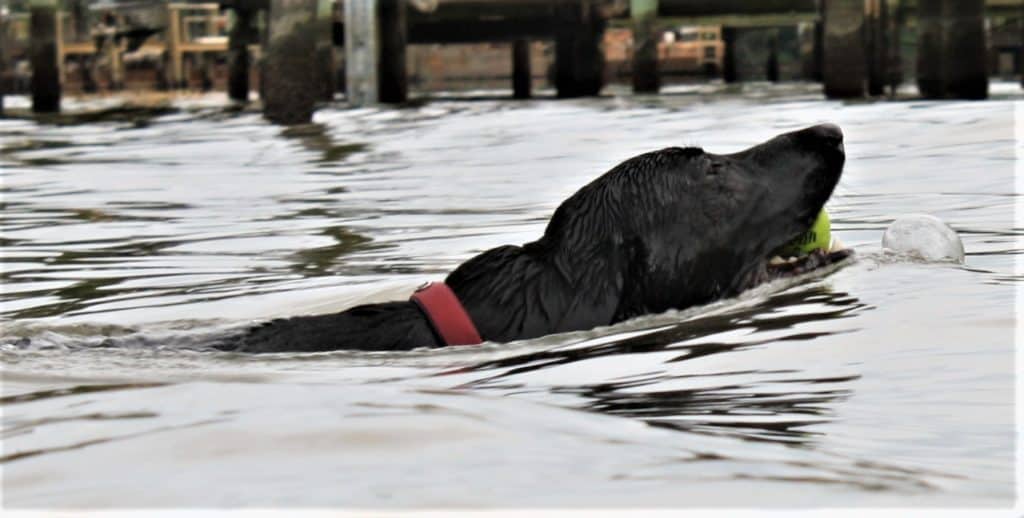Sporting Life

neck to get the right angles.
Beating the Dog Day Heat Carefully
By Dennis Doyle
My friend, Hobbes, sprinted across the deserted beach throwing a spray of sand into the air behind him and charging through the shallows. A number of onlookers, watched in awe as he ripped through knee-high currents into deeper water, throwing geysers of water to each side, then settled into a mighty swim stroke toward the distant, barely visible and apparently struggling entity.
This was not a lifeguard rescue episode, though, it was just another adventure with my hunting and fishing partner. Hobbes is my 2-year-old black Lab and he was chasing a retrieving dummy I had thrown into the distance off our community beach on the Bay. He is a bundle of energy, so much so that unless he gets in a healthy period of intense exercise, he’s not a happy camper.
Usually that’s not a problem, a tennis ball or a retrieving bumper, an open field and a strong right arm works out well for both of us. But beginning in July, all of that changes.
The Dog Days of Summer, so named by the appearance of the dog star, Sirius, which begins rising at the same time as the sun and our outdoor temperatures mark the peak of summertime. That also marks the time to switch to a water-based environment for dog exercise.
Since a hunting dog’s normal internal temperatures are usually about 102 degrees and their furry coats retain heat, exercise in weather much above 70 degrees can quickly raise their body temps to potentially deadly levels. Water exercise is one of the few intense activities that both man and beast can enjoy this time of year with little fear of an adverse reaction, within reason of course. Water exercise in summer is one of the few high level, physical activities that dogs can really enjoy but it may also include other summertime dangers of which many are unaware.
Although Bay water temps this time of year remain well below a dog’s body temp, their internal temps can quickly rise too high for comfort from high air temps and exertion alone, so always keep a close eye on your companion. Watch their tongue size: panting is how they cool their bodies, when the tongue gets lengthened and engorged from rapid breathing or panting it’s a sign they’re beginning to overheat. Slow down and give them a chance to recover. Wait until their breath rate slows and normal tongue size returns before you resume activities.
Carry and teach them to drink from a plastic bottle of water, it’s obviously cleaner than Bay waters. If you wouldn’t drink it neither should they—provide them an alternative. Any waters which exhibit scum floating across the surface should be avoided. It may well be a sign of the remnants of blue green algae, which exhibit colors from mud-colored dust to mixed colors with an oily sheen. This algae residue can be fatal to animals and cause severe sickness in people.
Never let your pets forage unattended along the shore line. Dogs are omnivorous, which is a pleasant way of saying they may eagerly eat anything they find interesting. Most deceased Bay critters, including shellfish, that lie in attractive repose along a Bay shoreline have died from something that may well also be toxic to your pet. Stay aware. Take it away from them.
Hose them off thoroughly after their swim; you can include a touch of shampoo or conditioner from time to time to keep their coats in top shape.
Editor’s note: Watch for our special pet issue next month with more stories on having fun with our Bay region pets and their care.
*****
Fishfinder:
The hot weather continues as does the closed season for rockfish on the Bay. It reopens August 1. The target species these days are northern snakeheads, blue catfish, channel catfish, white perch, spot, croaker and blue crabs. The crabs (males only, 5 ¼ inches) are currently difficult to find, but can be found usually in 5 to 7 feet of water up in the tributaries over sand and mud bottom; caught on hand lines, trot lines and traps using chicken and razor clam as baits. Getting out early and later in the day is usually the best tactic, as the bite fades in the high heat of the mid-day and so do we. Stay cool and hydrated, avoid alcohol until you’re back ashore.
